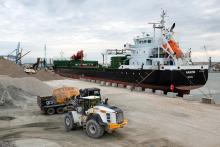
Cemex UK's new Tilbury plant has been opened to meet future demand but the design also includes meeting future needs for greener transport
Cement production is widely known as one of the most energy intensive industries but efforts to reduce the embodied CO2 are being made. Many cement plants now use alternative fuels, making use of waste materials and blending cements with other secondary materials.
Nonetheless, one of the UK's newest cement facilities is not only designed to make the best use of green technology but is also centred around flexible transport options.
The site is strategically placed in the south east, which accounts for 30% of UK cement consumption and yet - until now - did not have any cement production facilities. "We have made the long term investment despite the downturn because the market needs secure investment for the long term," said Cemex UK vice president commercial logistics and building products Graham Russell.
The site is not all new - it was acquired by Cemex when it took over RMC in 2005 and was used as an import facility. But, according to Cemex, the new plant is 42% more efficient than the old one, saving some 3300tonnes of CO2 per year.
Construction on the site started in 2007 and has involved 150 different contractors. Work started by clearing old buildings and then piling up to 20m below ground level to support the new structures. In total 735 piles were installed at the site with 6000m3 of concrete, 42km of cables and 3000tonnes of steel The site can produce three grades of cement - CEM1 which is basic cement and clinker, CEM2 with 70% CEM1 and fly ash and CEM3 formed with 50% CEM1 and ground slag. The site started operation in May 2009 and now operates 24 hours a day.
Cemex claims that the facility offers a sustainable solution with blended cements, which can be 30 to 50% more environmentally friendly. The site also has a Loesche vertical grinding mill - the first of its kind in the UK cement industry - which is more efficient than other grinding methods. In addition to this, the whole site is computer controlled using an
But it is the options for incoming and outgoing deliveries that make this site an interesting proposition for the future. The site has berthing facilities for 30,000tonne ships with an 11m deep draft for incoming deliveries and also dispatch of materials direct to construction sites in central London.
Clinker is delivered from a variety of sources by road, rail and sea but for the moment will mostly come from Cemex's plant in Rugby. Gypsum is delivered from mines in East Sussex, while limestone comes from quarries in Leicestershire and ash from West Brunton.
Both the clinker and ash is transported by Iso-veyors, a more sustainable bulk transport system, which were previously used by the company to transport materials to T5 at Heathrow airport. The system provides a logistical and flexible alternative to traditional silos providing storage for 28tonnes of material per unit which can be transported by any combination of road, rail or ship.
The cylinder- shaped containers, which fit within standard container dimensions, are filled at source. The ash filled Iso-veyors are brought to Tilbury by rail and can then be moved by truck within the site and stacked up to three units high until the material is needed. It is anticipated that this transport solution will save 600,000 road miles and 720 tonnes CO2 per year.
According to Cemex UK sustainability director Andy Spence, it is the flexibility of the new Tilbury site that is key. "The site is designed to be flexible to allow it to adapt to future needs," he said.









